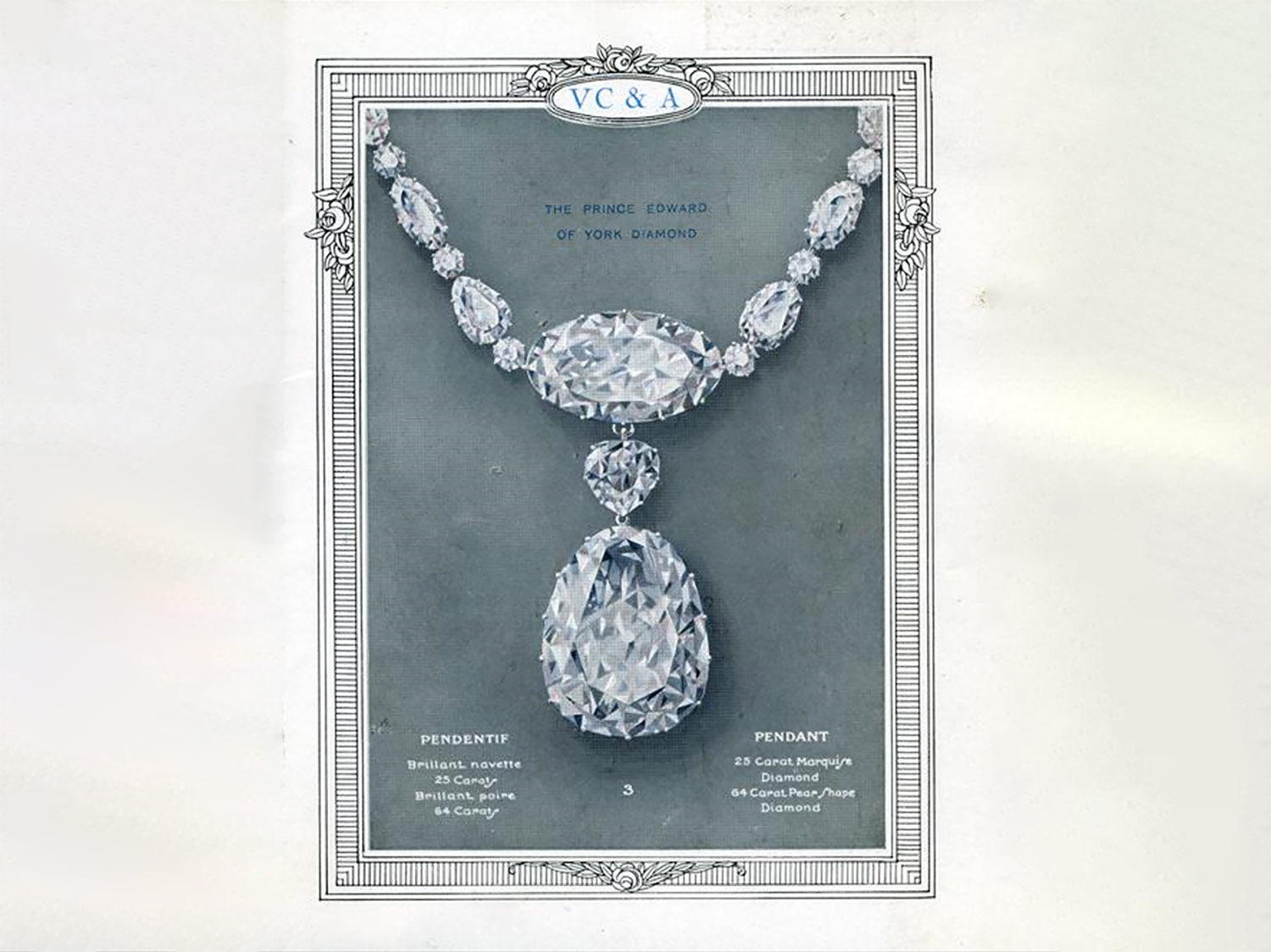
VAN CLEEF & ARPELS AND DIAMONDS: A PASSIONATE CENTURY-LONG QUEST
“There is a historic diamond on display outside in one of the store windows, a huge pear-shaped gem known as the Prince Edward of York, which had previously belonged to an English family. […] Its sparkling shimmer seems to attract passers-by like a magnet attracts iron, and all day long a human hedge stands in ecstasy before its beauty.” This is how an article in the December 25, 1921 Daily Mail Continental Edition described the exhibition and sale that Van Cleef & Arpels held at Place Vendôme. Among the creations was a scintillating necklace made of diamonds of various sizes, including a pendant made of a 25-carat “marquise-cut brilliant” diamond and a “pear-shaped brilliant” diamond of over 60 carats, named the Prince Edward of York. The latter was the first major diamond that the Maison acquired and remounted. It was discovered in South Africa’s Kimberley mine in 1894 and was said to have been named in honor of Prince Edward’s birth, Queen Victoria’s great-grandson and the future Duke of Windsor. This necklace reflected a true taste for the rarest stones, a patient, well-honed quest that would be carried on by the various generations of the Maison.
From the beginning, the Maison was created with gems at its heart, following the marriage of Estelle Arpels, daughter of a gemstone merchant, and Alfred Van Cleef, son of a lapidary. The history of Van Cleef & Arpels was then marked by romantic acquisitions, taken to auction and discussed by the press, with historic stones that traveled from Golconda in India to the Place Vendôme and princess-like jewels that were acclaimed by both royal courts and stage and screen personalities.
In the late 1930s, the order placed for the wedding of Princess Fawzia of Egypt to Prince Mohammad Reza Pahlavi, the future Shah of Iran, turned into a treasure hunt for the Maison. “It took many months for the Maison Van Cleef & Arpels, the great jeweler who put together [the tiara], to collect the 54 large, pear-shaped, brilliant diamonds, […] specially cut from the rough stone, and displaying extraordinary regularity,” the illustrated daily Excelsior reported on March 4, 1939.

“Princess Fawzieh’s (Fawzia) parure will be complemented by a necklace whose 90 large, brilliant diamonds, which have a total weight of 115 carats, required six months of searching in every diamond market.” Queen Nazli of Egypt also dazzled alongside her daughter, particularly due to the collarette necklace—now in Van Cleef & Arpels’ patrimony collection—totaling over 200 carats of round and baguette diamonds.
The Maison’s most prestigious creations highlight the appeal of white diamonds, traditional symbols of power and love, as well as colored diamonds, which are rare and often shrouded in mystery. Several spectacular stones crossed paths with the Arpels brothers. This included the Blue Heart, a 31-carat heart-cut blue diamond discovered in South Africa in 1908 and acquired by Van Cleef & Arpels in 1953 after having several owners. Unveiled to the press in the Crystal Room of New York’s Plaza Hotel, the stone was topped by a pear-cut pink diamond and a triangular blue diamond, which together formed the pendant of a sparkling river of diamonds. The piece—which then traveled to Paris by registered mail—was the pleasure of Zizi Jeanmaire, who wore it to the Ball of Versailles, which was organized in the Orangerie by the Cancer League in June 1953. Point de Vue described it like this: “The famous dancer looked at herself in the mirror and squealed with delight. One of the directors of Van Cleef & Arpels had just fastened around her neck the necklace that held the most beautiful diamond in the world, the Blue Heart. […] It was magnificent, and it was difficult to decide which to admire more, its purity or its incomparable brilliance.”
In 1960, a 34.64-carat cushion-cut pink diamond made photographers’ flashbulbs pop and columnists’ ink flow. Its history was a thing of dreams. Connoisseurs claimed that it had been owned since the 18th century by the Nizams of Hyderabad, the state of India where the famous Golconda mines were located. The stone was auctioned by Sotheby’s in London at a sale the press dubbed “39 Millionaires” because of all the well-heeled attendees. Van Cleef & Arpels won the auction for £46,000, or 644,000 new francs. Described in the catalog as extremely rare because of its combination of weight, color, and brilliance, the diamond immediately caught the attention of Louis Arpels, as reported by a journalist from Paris Dakar on April 5, 1960. “It is so beautiful, so pink, so bright, that as soon as he saw it, Mr. Arpels fell madly in love. […] He spoke to me about his diamond this morning with passion, with tenderness. He said, ‘If you are very lucky, you will see one stone like this in your lifetime. […] All my life, I have been looking for a pink diamond. The moment I learned there was one for sale, I ran to see it; it was in London, but believe me, I would have gladly gone to India, China, or the far reaches of Africa or America.’” Louis Arpels asked his nephew, Jacques, to attend the auction; he was a seasoned buyer, well known to auctioneers, as evidenced by the handwritten notes he wrote all over auction catalogs. To celebrate the acquisition, his brother Pierre hosted a “naming ceremony” (according to the invitation) on April 5, 1960. It took place in the salons of 22 Place Vendôme in the presence of the Maharani of Baroda, one of the Maison’s illustrious clients, and her son, the young Prince Jagat Singh. The diamond was given the name Princie in his honor, and it still held that name when the stone returned to the limelight at Christie’s in 2013.
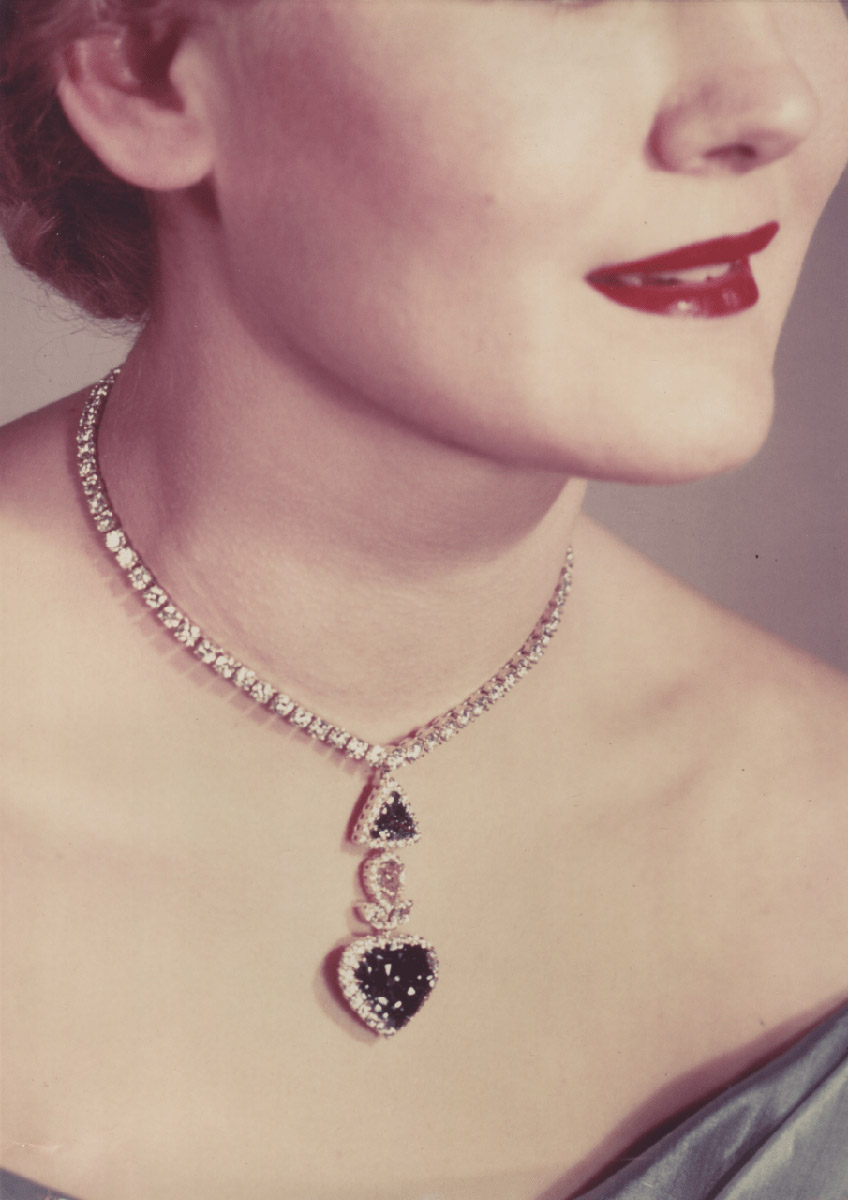
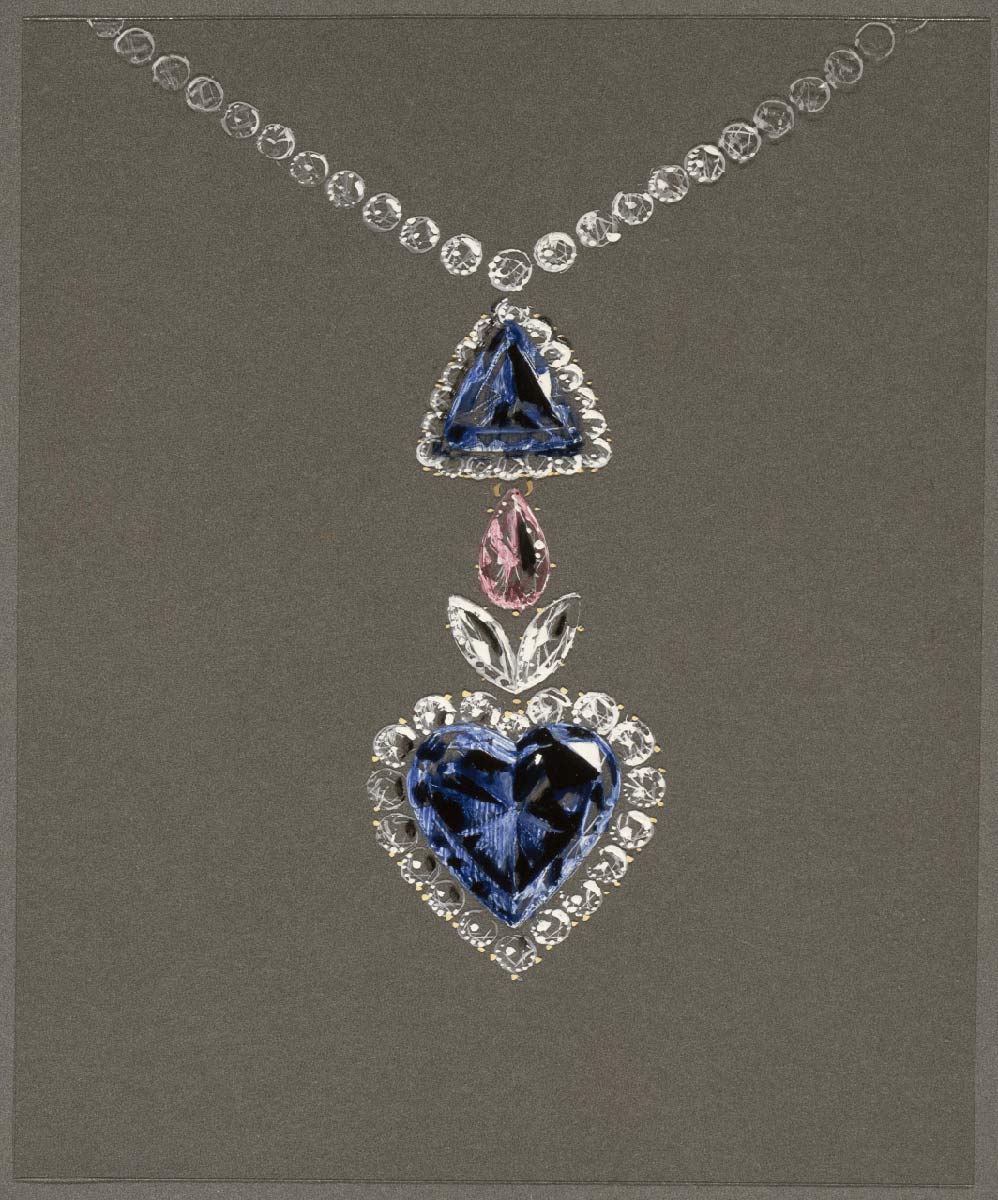
In December 1964, a historic diamond that belonged to the French Crown Treasury was sold at Sotheby’s in London. Once again, Jacques Arpels was in attendance. The 30.58-carat Mazarin featured an emerald cut that reflected the vestiges of the cushion shape given by 17th-century Parisian lapidaries at the famous Cardinal’s request. Setting the world record for the public auction price of an unmounted diamond at £70,000 (960,000 francs), it entered the Van Cleef & Arpels collection after a battle of connoisseurs. “I’m always nervous before a sale, like an artist, a jockey, or a runner. But I’m determined to succeed when I decide to buy a stone, and in general I’m quite lucky,” Jacques Arpels told journalist André Burnat.
The Maison’s love of exceptional gems continues unabated and new pages have been added to its story over the decades. On April 1, 1971, when the jewelry collection of singer Ganna Walska went up for auction, Van Cleef & Arpels purchased a 96.62-carat briolette-cut yellow diamond. It would then be mounted on a Bird clip made entirely of precious stones—now in the patrimony collection—that carried the sparkling faceted drop in its beak. In the 1990s, the 30.99-carat Arcot 1 white diamond was used as the pendant of a Van Cleef & Arpels necklace. The pear-cut stone was historic. Given as a gift to Queen Charlotte of England by the Nawab of Arcot at the end of the 18th century, along with other diamonds of lesser weight, it went from crown to tiara, was unmounted several times and re-cut, before being sold set by the Maison in 1993.
So goes the life of legendary stones: pampered, collected, passed on, and enhanced. Van Cleef & Arpels demonstrated this tradition once again in 1999 with a set purchased from a collector who loved colored diamonds. “More than five hundred gems (523) with incredible colors from the depths of the Earth enter the Maison’s ateliers. […] Ten shades of yellow, from the lightest straw to radiant orange, mingle with delicate pale pinks and purples; the poetry of sky blues and blue-grays contrasts with the depth of olive greens. These delightful variations are available in most of the diamond cuts listed: brilliant, heart, cushion, emerald, marquise, pear, princess, radiant, and oval, thus creating a well-reasoned inventory of possible combinations of shapes and colors,” the press release stated. For two years, the Maison’s designers and artisans worked to enhance them through a set of thirty unique pieces called Collection of the Century, which sounds like the announcement of a new millennium devoted to gems.
THE MAKING OF A HISTORICAL COLLECTION

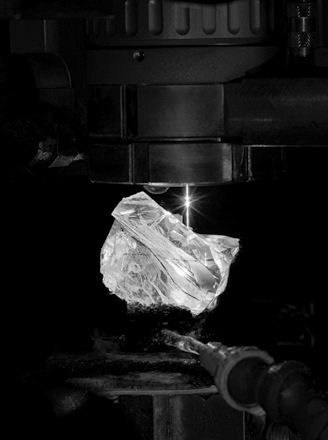
Through the years, Van Cleef & Arpels has consistently paid tribute to the beauty of gemstones, celebrating their colors, their brilliance, and their elegant shapes. In keeping with this tradition, since the early 2000s, the Maison has dedicated High Jewelry collections to them, most notably Collection of the Century (2002), Pierres de Caractére (2006), Pierres de Caractére – Variations (2013), Émeraude en majesté (2016), and Treasure of rubies (2019). This year, it is unveiling a significant set of pieces featuring exceptional white diamonds, the product of an exhilarating journey of passions and expertise.
Van Cleef & Arpels’ high standards and taste have inspired it to surround itself with a network of experts, establishing close ties with the most prominent dealers, including some who specialize in diamonds. This quest for the rarest stones is inextricably linked to great patience. From bringing together perfectly matched stones, to creating harmonious sets of gems, to discovering a diamond of the highest quality, the Maison has a long history of enhancing jewels that ellicit a unique emotion.
The story of the Legend of diamonds – 25 Mystery Set Jewels collection began in 2018, when the Maison encountered a rough diamond, the Lesotho Legend. Presented to Van Cleef & Arpels by diamond dealer Taché, a long-time partner, the stone was initially exceptional for its weight: 910 carats. It was the fifth largest tough diamond in both size and quality ever minded. It combined a perfect D color, beautiful crystallization, and a highly sought-after Type 2A chemical composition. Type 2A diamonds are chemically the purest and have great optical clarity. First identified as native to India – in particular the Golconda region – they have since been found in several producing countries around the world. In this case, the stone was from the Letseng Mine in Lesotho, known as the home of gems and remarkable size and quality. The Maison’s collaboration with this mine that is committed to sustainable development ensures complete traceability of the rough diamond.
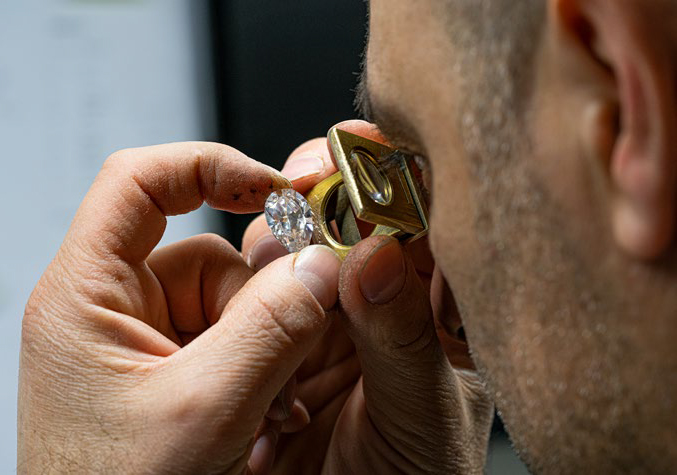
“The Maison seldom works with rough stones. We traditionally start with cut and faceted stones that are already suitable for use in jewelry. This is the first time in decades that we have been involved in a project from its starting point—the extraction of the stone—to the creation of a High Jewelry collection. The appearance of this extraordinary rough stone gave us this unique opportunity to tell a story around the diamond.”
Nicolas Bos, President and CEO of Van Cleef & Arpels
“Finding a stone of this size in its natural state is truly emotional. It’s the kind of thing we dream of but don’t dare to imagine. We are here at the beginning of this diamond, after its formation, when there has not yet been any human intervention. When I see a rough stone like this, I would like to keep it this way, because it is so beautiful.”
Director of the Van Cleef & Arpels Stones Department
“For me, Van Cleef & Arpels was the jeweler that could best showcase this diamond. When the Maison spoke to me about a collection centered around the stone, I knew it could become a very interesting venture.”
Jean-Jacques Taché, Diamond Dealer
Van Cleef & Arpels and Taché sought help from Diamcad—a leading diamond cutter in Antwerp—to plan the cutting and faceting of each stone. These specialists in cutting exceptional rough stones analyzed the Lesotho Legend, which proved suitable for producing large diamonds. Working their way around the stone’s inclusions, the experts used state-of-the-art technology to envision the position of each gem in the heart of the rough stone. This was a unique opportunity for the Maison to choose a combination of cut stones that matched its wishes, both in shape and size. These included a 79.35-carat specimen and others weighing 51.14, 31.24, and 25.06 carats. Van Cleef & Arpels worked hand in hand with the various experts involved in the project to choose the cuts most likely to awaken the designers’ creativity. Every shape, whether oval, pear, emerald, or Asscher, echoed the Maison’s history and taste for “fancy” cuts. The gems were then given the ideal proportions, meticulously studied to best enhance their brilliance and beauty while meeting the aesthetic criteria of the Maison. Van Cleef & Arpels also had the rare opportunity to create perfect matches, combining stones of identical size and weight.
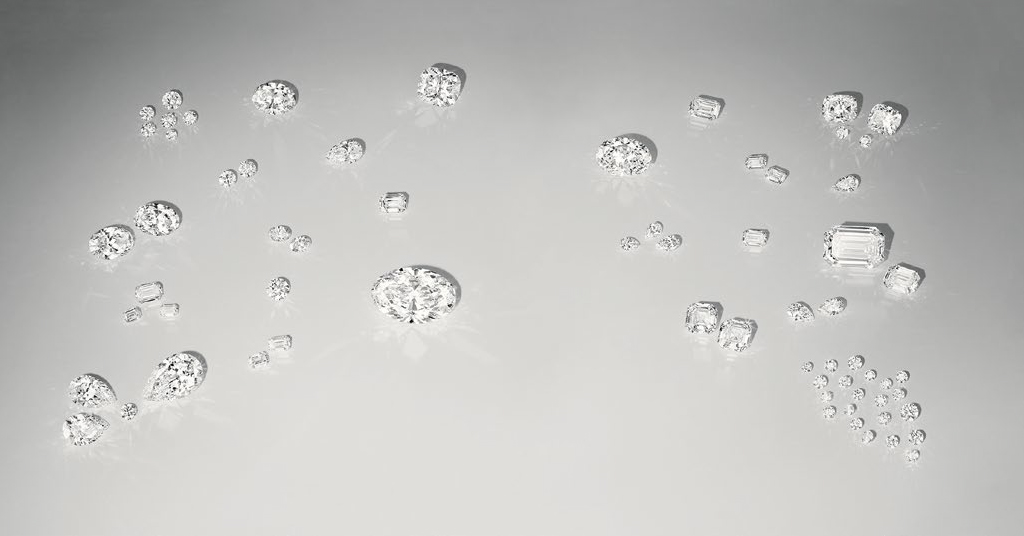
The combination of gems was decided with the help of 3D software that allowed each cut diamond to be seen inside the rough stone. For almost a year, gemologists’ eye was combined with cutting-edge technology to perfect these combinations, avoid inclusions, and limit the loss of material. Once mapped, the rough stone was sawn to shape the individual diamonds. This step presented new challenges: since diamonds are a particularly hard material with cleavage planes, they are difficult to cut. For the first section of the rough stone, the traditional cleavage technique was used.
“This involves making an incision in the stone and inserting a knife that we strike to split the stone in two. We very rarely use this technique anymore now that we have laser technology, but it was the only way to get the desired result with this stone.”
Eli Huygelberghs, Director of Production at Diamcad
The diamond cutter then worked each stone, giving it facets that were polished to give the gems their full brilliance. These various steps produced a family of 67 diamonds totaling 441.75 carats, nearly half of the original rough stone’s weight. Of exceptional quality—Flawless to Internally Flawless—each one reveals the distinctive nature of the original rough stone, like clear, scintillating water. Alone or in pairs, trios or sets, they have inspired the Maison’s designers to create a historic collection infused with Van Cleef & Arpels’ distinctive style.
“This project was a fantastic human adventure. Working alongside long-time partners has made our relationship even closer. We have crafted a piece of eternity, much like the diamond itself.”
Jean-Jacques Taché, Diamond Dealer
“Developing Legend of diamonds took about four years from the time we first saw the rough stone to the release of the finished pieces. I’m very proud of the collection. Thanks to the work of all the teams at Van Cleef & Arpels, I think we have successfully shown that an exceptional diamond can be the starting point for an extraordinary collection that will be a milestone in the history of the Maison.”
Nicolas Bos, President and CEO of Van Cleef & Arpels
FROM THE DESIGN STUDIO TO THE PLACE VENDÔME WORKSHOPS

At the heart of Van Cleef & Arpels, the Design Studio was committed to upholding its highly recognizable style through the 25 pieces of the collection. The designers worked hand in hand with expert gemologists and the High Jewelry Workshops to design precious settings inspired by the history of the Maison for the diamonds from the rough stone. Each setting created through this collaborative approach was designed to reveal the intense brilliance of the stones and magnify their cut, while emphasizing the Maison’s style and expertise. Van Cleef & Arpels opted to combine each of the gems with the Mystery Set: one of the most complex signature techniques mastered by the Place Vendôme Workshops. Bringing together curved lines and the intense interplay of colors in rubies, sapphires, and emeralds, the Design Studio worked to infuse lightness and movement into the most precious materials. Within the collection, bows are three dimensional, ribbons softly come undone, and asymmetry gives certain pieces a subtle energy.
“The first six months of designing the collection were particularly intense. We had to envision creations that embodied the Maison’s style, that highlighted its expertise, such as the Mystery Set technique, while also enhancing these diamonds which, at that point, had not yet taken their final shape. The challenge was to design harmonious pieces that brought all these elements together without one overshadowing the others.”
Thomas Pozsgai,
Director of the Van Cleef & Arpels Design Studio
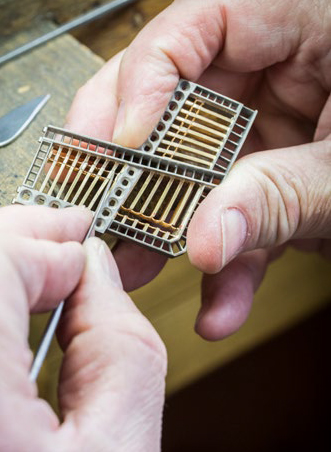
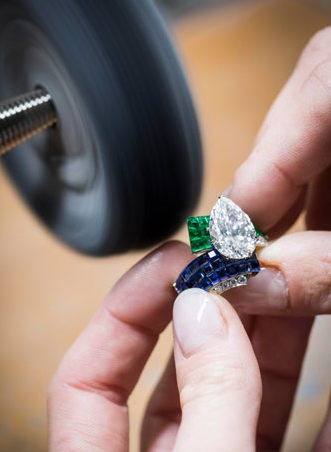
The entire collection, the result of more than 30,000 hours of work, comes to life thanks to the Mains d’Or (literally “hands of gold”), the artisans of the Van Cleef & Arpels Workshops on the Place Vendôme who carry on the tradition of expertise that is constantly being perfected. To meet each new challenge, the jewelers, setters, lapidaries, and polishers communicated and shared their experience to produce a collective work. Links, invisible fasteners, and discreet articulations express the Maison’s distinctive high standards, and the artisans’ meticulous attention is apparent on both the front and the back of the pieces.
“The collection’s 25 pieces are all equally complex. They required the participation of many crafts and experts we trust. The Design Studio came up with designs and it was our job to make them possible. Together, we created the initial shapes, the mechanical elements, the wearing comfort, and finally, the transformations. It was a truly collaborative effort.”
Grégory Weinstock,
Director of the Van Cleef & Arpels High Jewelry Workshops
To unite sparkle and radiance, Van Cleef & Arpels also committed to fully highlighting the beauty of the stones. The metal on the pieces is concealed to showcase vibrant colors thanks to the Mystery Set technique, which is used on an entire collection for the very first time. Patented by Van Cleef & Arpels in 1933, this setting technique is a true jewelry achievement and one of the Maison’s signature skills. Its secret is in the use of gold rails in which meticulously cut stones—usually rubies, but also sapphires and, more rarely, emeralds or even diamonds—are fitted one by one. Once in place, the gemstones perfectly cover the set surface, giving the piece a velvety radiance. In 1937, the Maison also developed the Individual Mystery Set, in which the stones are held individually.
Starting in the 1990s, Van Cleef & Arpels developed new techniques such as the Hexagonal Mystery Set, the Navette Mystery Set, and the Vitrail Mystery Set. Chosen to match the inspiration of the piece, they produce striking effects of movement, depth, and transparency. Today, the Legend of diamonds – 25 Mystery Set Jewels collection shines new light on the historic traditional technique with three colors of gemstones. Some creations even combine sapphires and emeralds on the same structure, creating an aesthetic that is as innovative as its execution is skillful.
The level of expertise needed to create a Mystery Set piece is such that only a handful of lapidaries and jewelry artisans hold the secret. The process is the reverse of traditional setting techniques, where the gold is pressed over the stone to hold it in place.
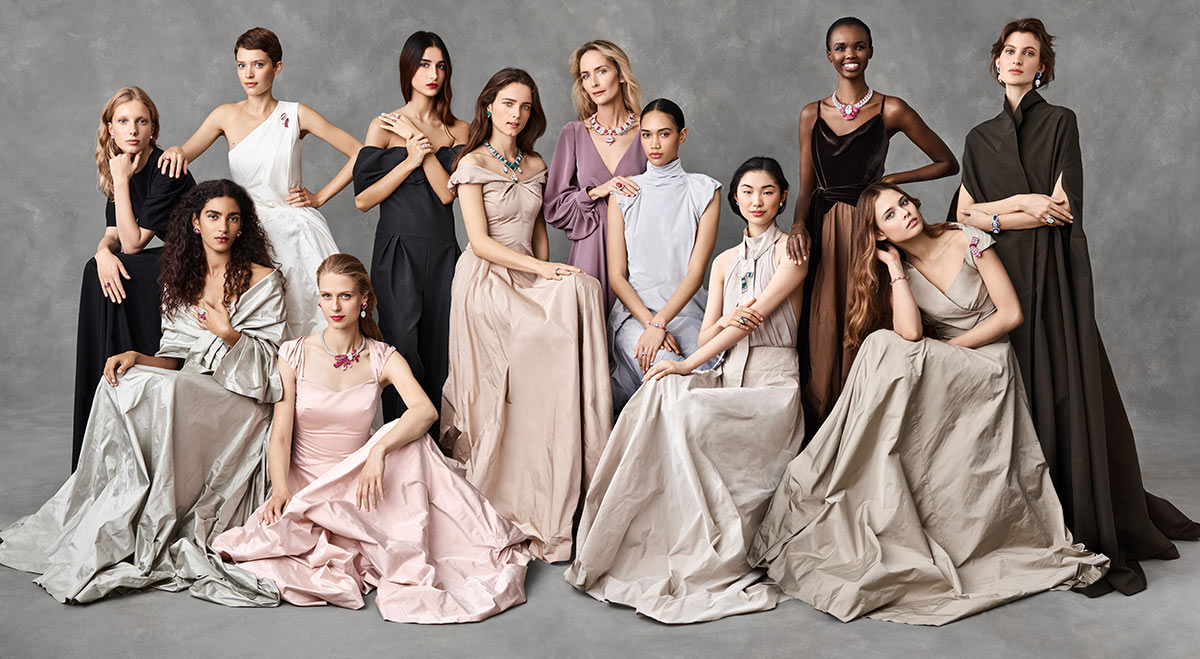
Here, the stone is fitted to the metal: grooves are dug in the culasse of each gem, so they can be slid onto the metal structure. More than 3,000 stones were needed for the collection. Finding materials that met the quality requirements and then sorting the batches represented a real challenge for the Maison’s gemologists, aiming to create sets of consistent color and purity. The experts selected the gems by eye and in daylight according to very precise criteria: generous culasse and high table, intense and uniform color, as well as clear material. They were then hand-cut by the lapidary in the workshops to fit perfectly in place on the creation. The collection’s pieces feature stones that are either faceted or buff-topped, i.e., polished on the surface to create a soft relief.
Another hallmark of Van Cleef & Arpels is its technical ingenuity. This is reflected in the many transformable pieces that mark its history, such as the Passe-Partout model created in 1938 and the Zip necklace from 1950. The creations of the Legend of diamonds – 25 Mystery Set Jewels collection also undergo astonishing metamorphoses, allowing up to six different ways to wear some of them. For example, the central diamond of the Atours Mystérieux necklace can be detached, replaced by an Individual Mystery Set motif, and simply slipped onto a chain, while that of the Collerette Mystérieux necklace can be used to adorn a matching ring. Meanwhile, the pendants of the Chevron Mystérieux earrings can be added to the necklace of the same name, whose central diamond is also detachable to be worn alone. From rings to pendants, from necklaces to earrings, each transformation reflects the Maison’s perpetually renewed creativity.
ATOURS MYSTÉRIEUX
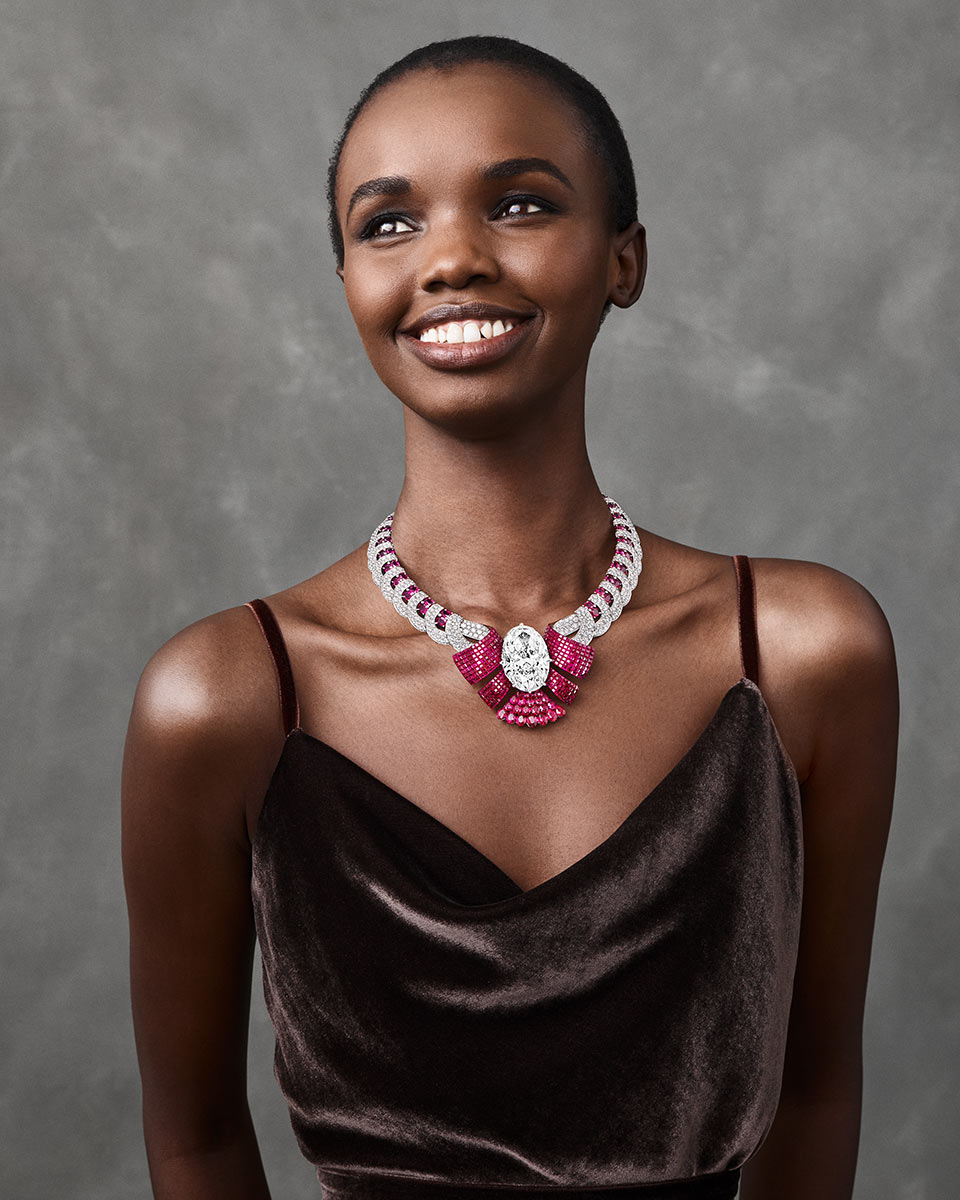
The heaviest stone in the collection, this 79.35-carat diamond is given pride of place in the Atours Mystérieux necklace. To emphasize the brilliance of its material, the Maison selected an oval cut with harmonious proportions that are both slender and full. Its 57 facets multiply the stone’s brilliance while its shape and the size of its table offer a dive into its pure waters. The diamond magnified in this way sparkles among Traditional Mystery Set and Individual Mystery Set rubies; the second technique allows each gem to be held separately without any metal showing. The oval rubies seem suspended, their color and flamboyant appearance intensified by light passing through them.

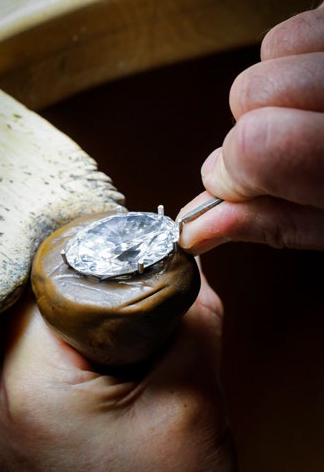
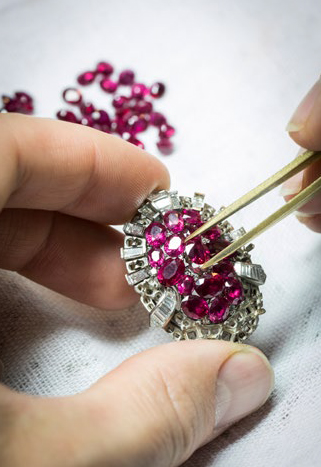
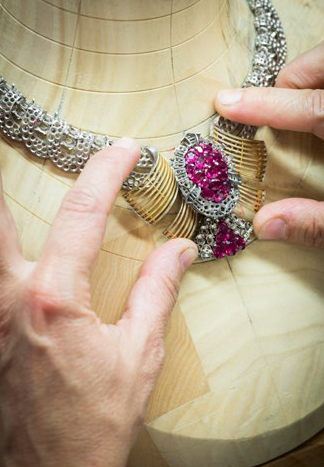
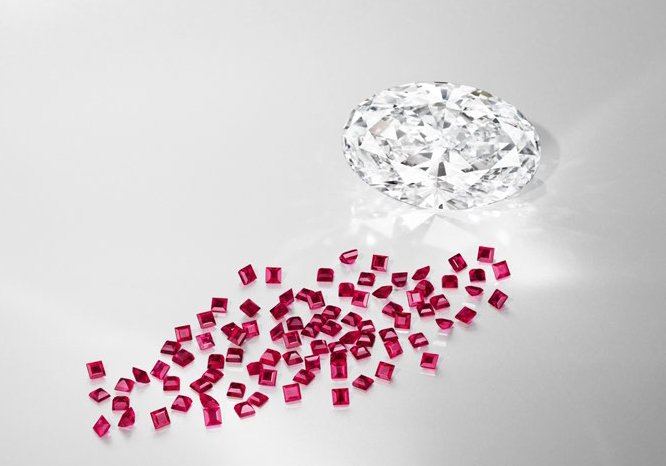
The diamond and ruby swirls are inspired by two iconic pieces in the history of Van Cleef & Arpels: The Collerette necklace, designed in 1938, and the majestic diamond necklace created for Queen Nazli of Egypt in 1939. Borrowing its two-color design from the former, the necklace is very comfortable to wear thanks to the skillful use of joints dotted around the neck. This care reflects the meticulous attention paid to every detail. This transformable creation includes and Individual Mystery Set composition that can replace the central diamond, which can also be worn on a chain when detached.
COUTURE MYSTÉRIEUSE AND COROLLE MYSTÉRIEUSE
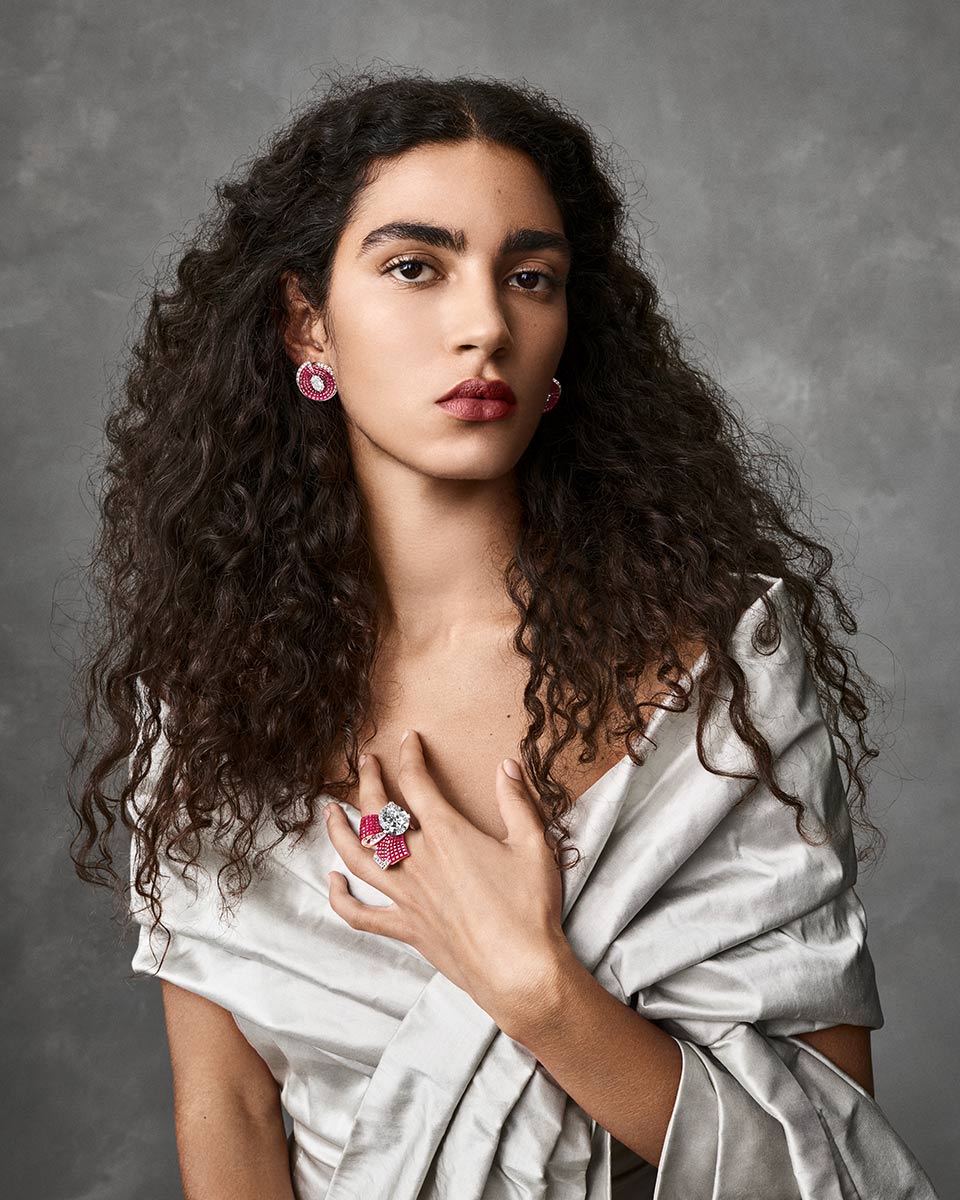
Like a freshly tied ribbon on the Couture Mystérieuse ring swirls of Traditional Mystery Set rubies seem to spring from an oval diamond of more than 18 carats, held in place by a three-pronged bezel. The ring’s airy structure allows the gem’s purity and whiteness to be admired from every angle. Its design was inspired by the Floating Ribbon brooch, created by the Maison in 1937. The piece’s asymmetrical line – a Van Cleef & Arpels signature – are enhanced by refined details: a border of baguette – cut diamonds around the ribbon and lines of round diamonds on the ring’s body, the inside of the ribbon, and the central diamond’s bezel.
Echoing the graphic lines of the Disques earring crafted by Van Cleef & Arpels in 1925, the Corolle Mystérieuse earrings feature a swirl of Traditional Mystery Set rubies encircling a pair of 1.60 and 1.59-carat oval diamonds. The concave shape of the design and the gradation of the rubies add depth to the creations, with the Mystery Set seeming to wrap around the diamonds in a cone. The pieces echo each other elegantly, each being a perfect reflection of the other. This spirit is also expressed in the cutting of the center diamonds: thanks to extremely precise diamond cutting, the two gems are identical twins, shining with the same brilliance on each side of the face.
VOLUTES MYSTÉRIEUSES
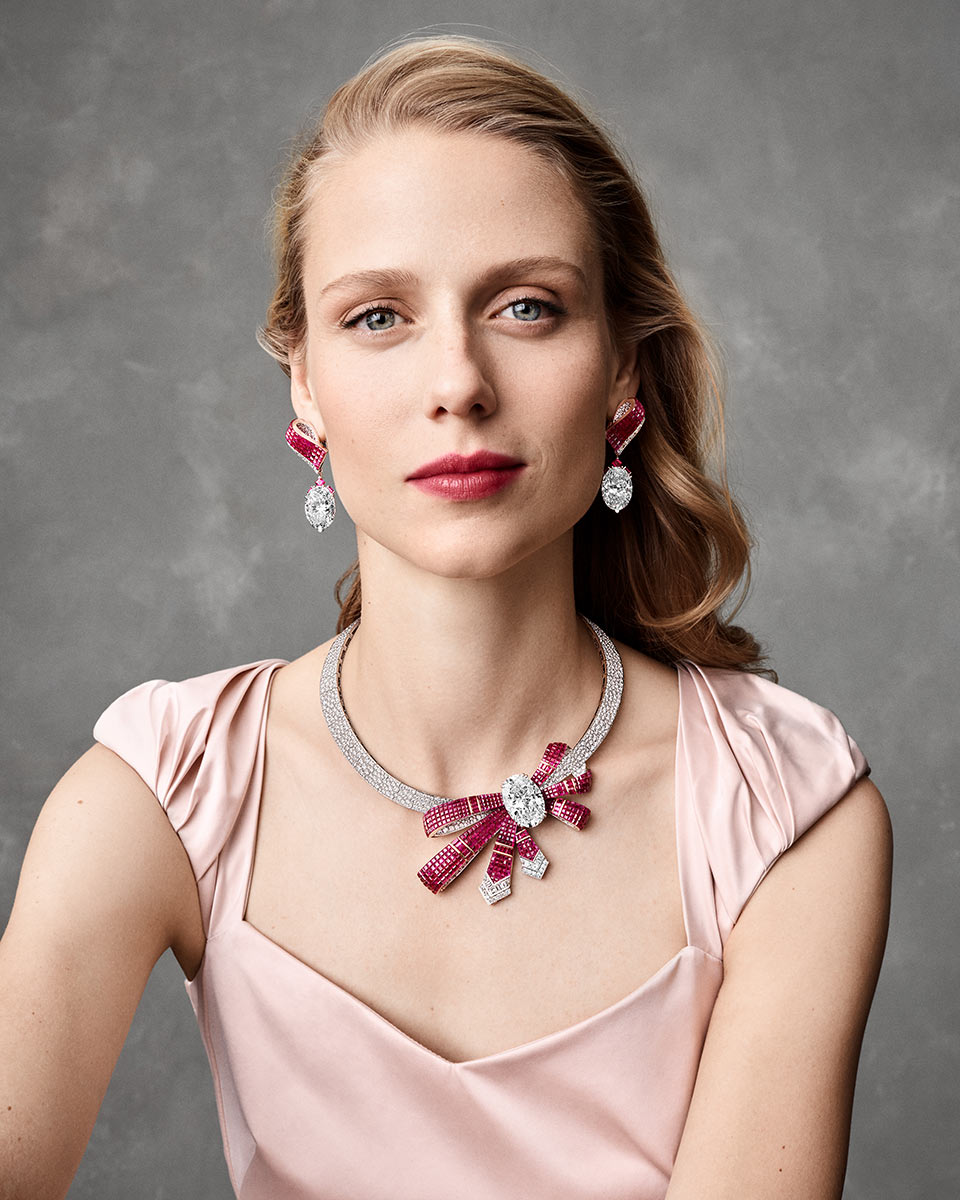
The multi-dimensional Volutes Mystérieuses necklace expresses the timeless elegance of the motifs from the world of couture that Van Cleef & Arpels has consistently interpreted throughout its history. The tight lines of its bow echo diamond clips from the 1920s, while the diamonds on the ribbon’s border evoke the Art Deco style. The Traditional Mystery Set rubies give the earrings a velvety appearance, crossed in placed by lines of rose gold and contrasting dramatically with the snow-set diamond choker. A subtle play of layers accents the piece’s contours, a real challenge for the Mains d’Or who had to adapt the Mystery Set to the creation’s convex shapes. A 30.61-carat diamond sparkles in the center of the jewel, its oval shape combining softness and elegance. A careful cutting reveals the stone’s particularly intense brilliance: the symmetry of the facets and the depth of the gem allow light to circulate inside the diamond, illuminating its crystalline material.
A pair of Volutes Mystérieuses earrings accompanies the necklace. Highlighting a meticulous setting work, they are adorned with two oval diamonds of 15.52 and 15.50 carats that form a harmoniously-sized and proportioned ensemble. These diamonds can be detached and added to the ribbons on the necklace. These diamonds can be detached and added to the ribbons on the necklace. The Maison takes the play on metamorphoses even further by offering a motif in diamond and Traditional Mystery Set ruby to replace the central diamond of the necklace, which can itself be attached to the center of a ruby composition and worn as a pendant.
SATIN MYSTÉRIEUX


The minimalist design of the Satin Mystérieux ring and earrings evokes some of Van Cleef & Arpels’ archives from the 1930s. The Mystery Set seems to encircle the finger and earlobe with the same fluidity as a satin ribbon, delicately emphasized by a row of square-cut diamonds. The ring is distinctive for its slight relief, with the band winding around itself in a striking graphic effect.
Each creation is adorned with a round “triple EX” diamond in a raised setting. This designation refers only to brilliant-cut diamonds with 57 facets that are perfectly symmetrical and polished – excellent cut, excellent symmetry, excellent polishing. The 3.22, 1.88 and 1.74-carat gems seem to simply be placed on each piece, with their contours standing out elegantly from the Mystery Set. Their sparkle is enhanced by their cut, whose facets reflect light brilliantly.
ORNEMENT MYSTÉRIEUX

The rich history of the Maison’s ribbon clips is embodied in the Ornement Mystérieux clip’s design. The piece is rooted in this tradition, with lines based on historical creations such as 1928’s Bow brooch or the Mystery Set jewels of the 1980s. Here, the clip featured 21 triple EX round diamonds totaling 12.09 carats. These brilliant-cut stones differ in weight (ranging from 0.29 to 1.54 carats), creating a gradation that highlights the piece’s dimension. With their raised setting, they punctuate the surface paved with rubies. The knotted part of the ribbon and its two ends are adorned with Traditional Mystery Set rubies, while lines of baguette-cut diamonds accentuate the whole piece’s shape.
CHEMIN MYSTÉRIEUX
Two rows of rubies, assembled using the Traditional Mystery Set technique, make up the Chemin Mystérieux bracelet. The bangle is punctured by six round diamonds, which are also triple EX with a raised setting. The stones are carefully held by long prongs that follow the curve of the diamonds to both protect the stones and emphasize their roundness. They contact with the rubies and baguette-cut diamonds, creating a gentle flow along the bracelet.
CHEVRON MYSTÉRIEUX AND LISERÉ MYSTÉRIEUX
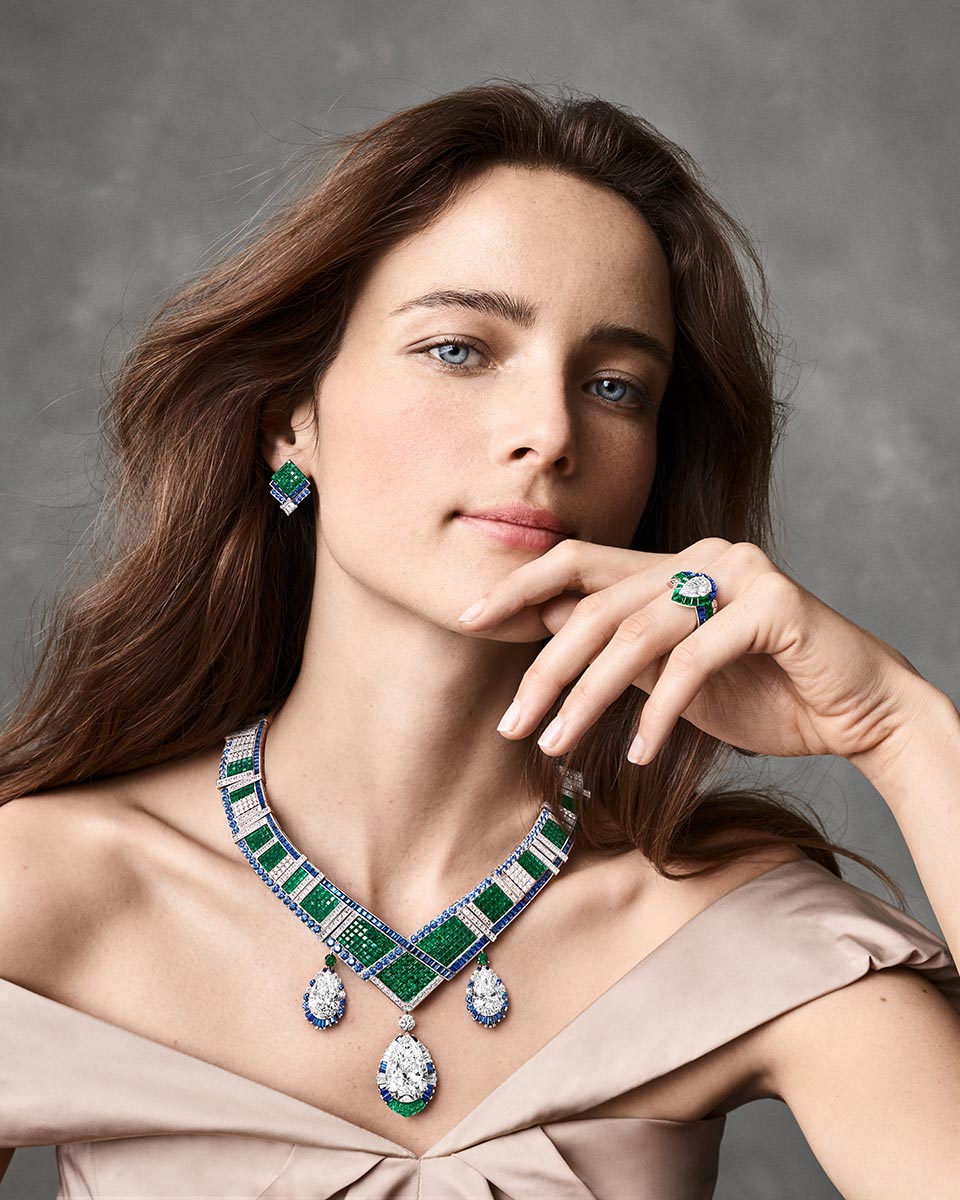
One of the key pieces in the collection, the Chevron Mystérieux necklace is inspired by 1950s fashion and the crossover collars that were popular on evening gowns at that time. Three majestic pear-cut diamonds of generous size drip from this colorful composition. The first, which measures over 31 carats, hangs in the center of the piece, flanked by the other two, weighing 12.18 and 12.07 carats respectively. Their balanced shape – neither too long nor too deep – multiples reflections thanks to the many facets around the table. These incredibly brilliant gems complement each other in size and illuminate the entire composition of sapphires and Mystery Set emeralds. The product of close collaboration between lapidaries and jewelers in the Maison’s workshops, this complex setting technique reveals the intense, uniform green of the emeralds, which contrasts with the sapphires’ deep blue. Combine with round and square-cut diamonds, these lines of gems intertwine on several levels in a skillful weave.
In keeping with the Maison’s tradition of transformable jewelry, the necklace offers six options for metamorphosis. For example, the central motif can be slipped onto a chain and the other two diamonds can be used to adorn earrings.
The Liseré Mystérieux ring uses the same combination of stones and colors. Inspired by the graphic lines of the Maha ring revealed in 2019 in the Treasure of rubies collection, it features rows of emeralds and sapphires in reverse symmetry, along with a DFL Type 2A pear-cut diamond of 2.50 carats. On each side of the ring’s body, a set of round diamonds highlights the colored gems, gracefully finishing this colorful ballet.
DRAPERIE MYSTÉRIEUSE TISSAGE MYSTÉRIEUX AND ASYMÉTRIE MYSTÉRIEUSE
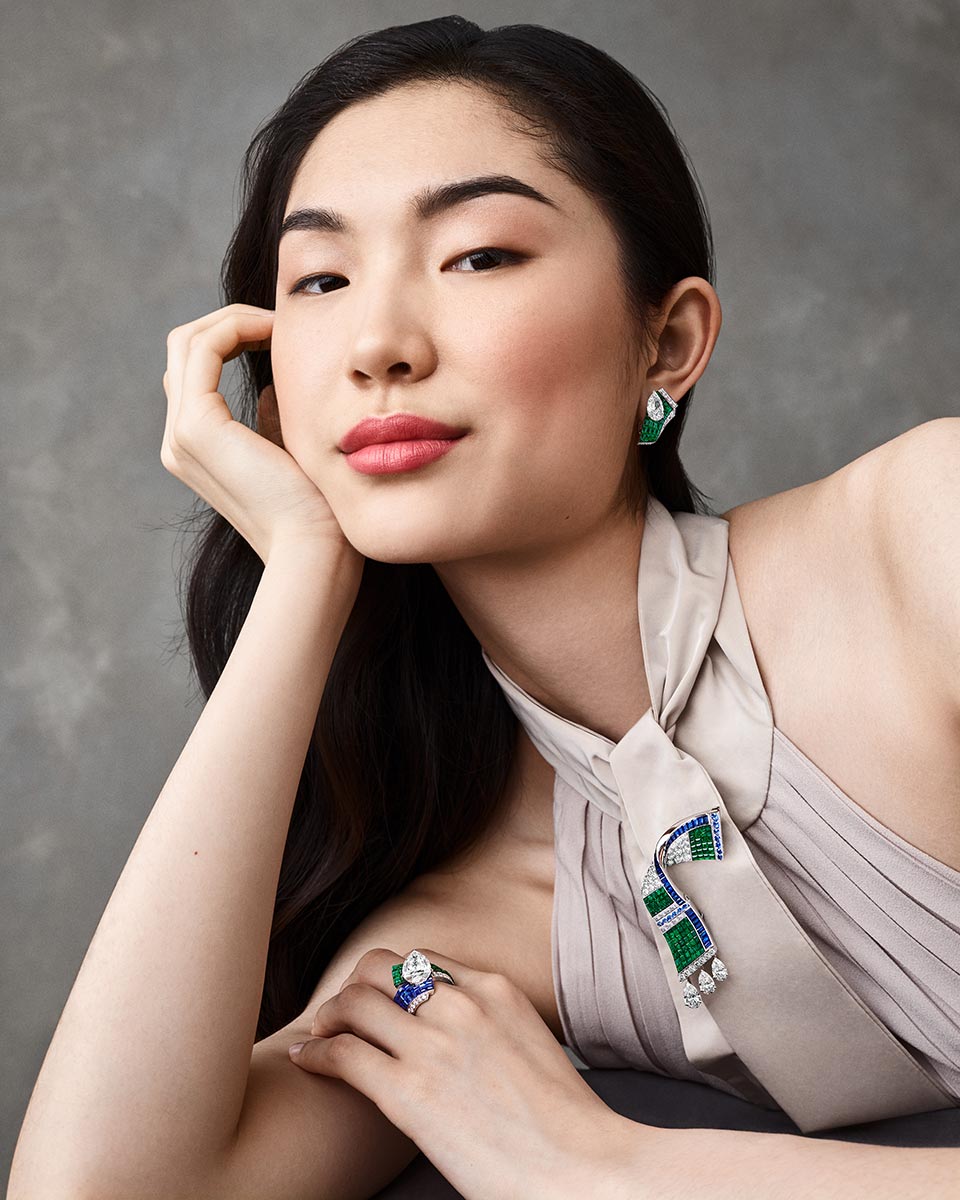
Inspired by the draped gowns designed by madame Grès in the 1950s, this realistic clip imitates the elegant fall of fabric. Thanks to precise jewelry work and setting, the precious stones covering its surface on different levels intertwine in a subtle play of dimensions. The Mystery Set emeralds and sapphires meet the snow-set diamonds adorning the fold on either side. Suspended from one end of the clip, three pear-cut diamonds gracefully illuminate the piece. These gems weighing 1.73, 1.26 and 1.09 carats respectively have a perfect D color, a clear IF or FL Type 2 A material and a generously shaped and elegant cut. Set on individual mobile bezels, they enhance the effect of perspective and poetically flow the movements of the silhouette.
This precious trio is echoed by the pear-cut diamonds of the Tissage Mystérieux ring and the Asymétrie Mystérieuse earrings. The stones are of similar quality, weighing 7.16 carats for the ring and 2.23 and 2.04 carats for the earrings. Their gentle cut has a balanced length to width ratio, allowing the gems to catch the light and multiply their fire. As they seem delicately placed at an angle on the two creations, they also emphasize the design’s asymmetry, which is characteristic of the Maison’s style.
DUO MYSTÉRIEUX AND GANSE MYSTÉRIEUSE


Since the 1970s, Between the Finger rings have reflected the spirit of innovation and inventiveness that inspires Van Cleef & Arpels. On these pieces which offer a gresh approach to the art of wearing jewelry, two motifs linked by an open ring face each other, delicately hugging the finger. On the Duo Mystérieux Between the Finger ring, this ingenious shape creates an inverted mirror effect, enhanced by the intense reflections of the two emerald-cut diamonds set on either side. Perfectly matched in size and weight, the two 2.10-carat diamonds echo each other in a joyful tête-à-tête on the hand. The emerald cut, recognizable by its long-faceted silhouette, highlights their limpid material. Ribbons of buff-topped Mystery Set rubies and pink sapphires seem to spring from the diamonds, flowing smoothly over the fingers. Subtle details on the ring’s body, lines of pink sapphires frame snow-set diamonds, completing the design.
Another DFL Type 2A diamond of 7.73 carats adorns the Ganse Mystérieuse ring with its lavish proportions. On this multi-dimensional creation reminiscent of a belt buckle, the emerald-cut stone is mounted in a raised setting, topping a ring body that is in buff-topped Mystery Set rubied and pink sapphires. Delicate lines of calibrated diamonds frame the piece, while a discreet row of round diamonds illuminates the side of the ring, lending the entire composition extra sparkle.
COLLERETTE MYSTÉRIEUSE

Like a couture-inspired collar, this graphic necklace drapes lightly on the neck. Alternating rows of diamonds and Traditional Mystery Set rubies, it is edged with a line of pink sapphires and square-cut diamonds that evoke delicate lace. Discreet links are hidden under the structure, making it very comfortable to wear, while a diamond-set dimensional bow hides the clasp on the back of the piece.
Two remarkable diamonds glitter at the heart of this precious necklace, one over 51 carats and the other over 10 carats. In addition to their D color and FL Type 2A purity, they are intimately linked by their perfectly proportioned emerald cut, traditionally called “tennis court.” Originally used for emeralds, this rectangular cut with beveled sides is characterized by a wide table, offering true immersion in the stone. Its concentric rows of facets on the sides and around the pavilion create captivating mirror effects that accentuate the luminosity of the two gems.
Sparkling in the hollow of the neck, the largest diamond can be detached to adorn a ring with architectural lines, while an Individual Mystery Set ruby design can be placed on the pendant. The flamboyant oval stones are thus set without visible metal, covering the surface with an opulent lightness.
LACIS MYSTÉRIEUX
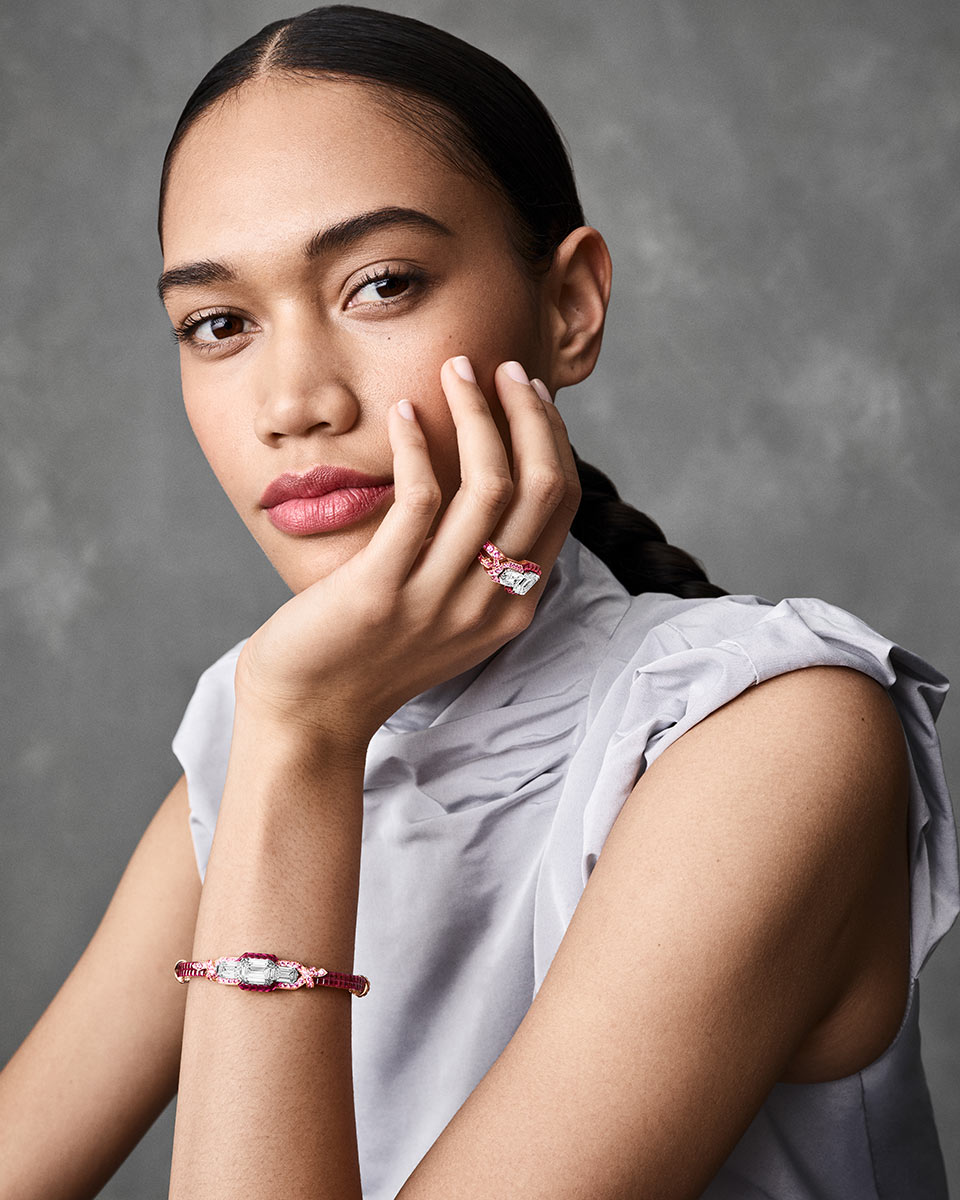
Inspired by the twill fabrics of the 1950s, these creations are embellished with precious pink sapphire ribbons intertwined with rows of buff-topped rubies. Shades of pink to fiery red give pride of place to a trio and a duo of diamonds, 3.99 carats, 1.17, and 1.19 carats for the bracelet and 2.36 and 1.54 carats for the ring. The Maison’s craftsmen paid particular attention to lining up the central stones girdle to girdle in a unique perpendicular arrangement that emphasizes the graphic lines of the emerald cuts. These reveal all the purity and brilliance of the material, enhanced by a carefully open-worked setting to let the light through.
In the center of the bracelet, the perfect symmetry of the composition contrasts with the curvature of the soft pink bows, each tired in a different way. This attention to detail is also revealed in the way the ribbons sometimes pass above and sometimes below the rubies. The same impression of natural fluidity is expressed in the ring’s structure, with a twisted band on one side and a chevron shape on the other. Its slightly raised tip ensures comfort when worn. The rubies mounted on rose gold rails using the Traditional Mystery Set technique have been polished on the surface to bring softness to the whole piece. The virtuoso combination of materials and techniques produces an aesthetic audacity that distinguishes these creations from all others.
DOUBLE RUBAN MYSTÉRIEUX AND PASSEMENTERIE MYSTÉRIEUSE
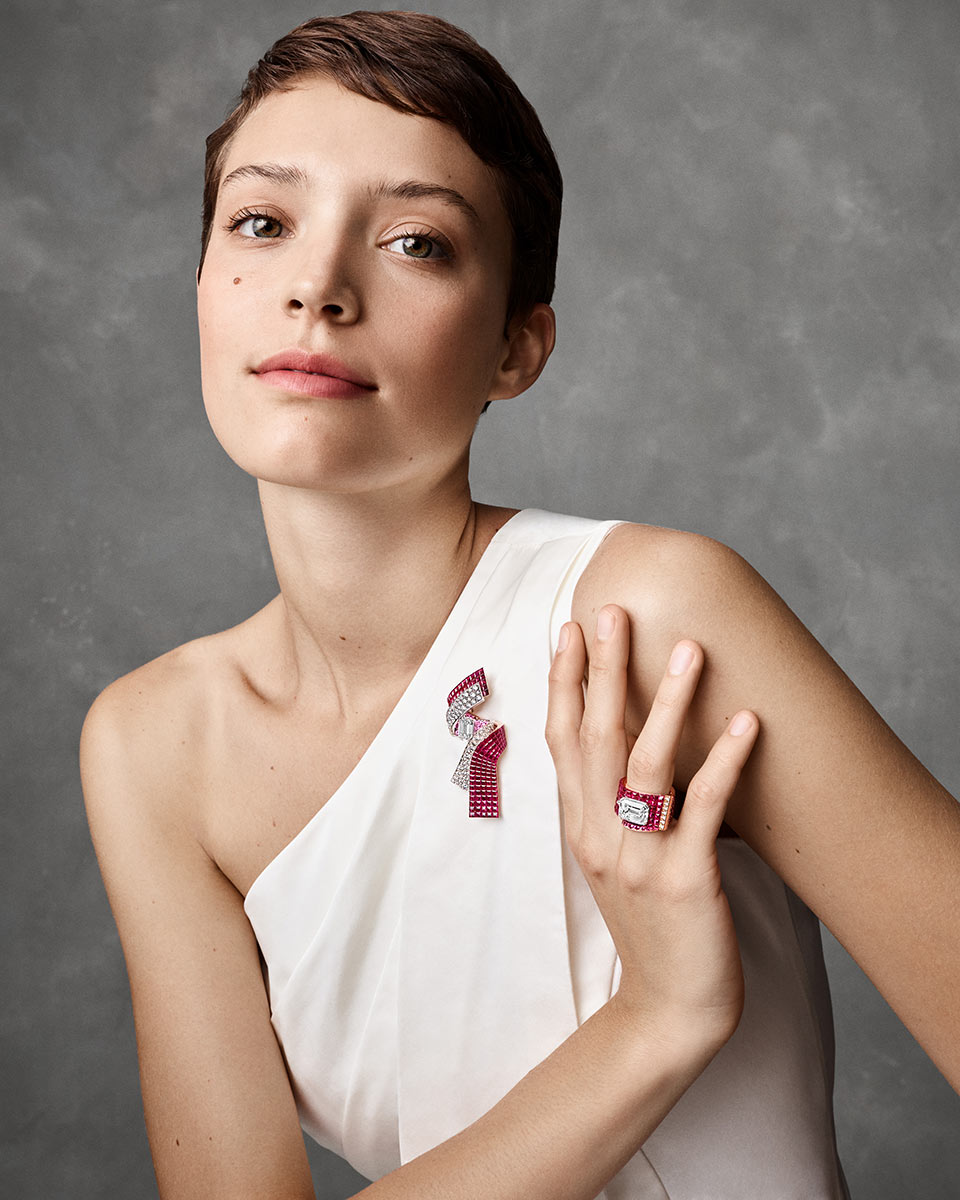
Reflecting the couture inspiration that Van Cleef & Arpels has cherished since its beginnings, the Double Ruban Mystérieux clip and Passementerie Mystérieuse ring provide striking effects of color and materials. Combining white gold, rose gold, and precious stones, these two creations seem as supple as fabric. While the clip is composed of several layers of gems superimposed in a display of curves and counter-curves, the ring evokes a sense of movement with its gently fluttering end.
On these pieces, two emerald-cut diamonds – a 5.23-carat stone crowning the ring and a 3.08-carat one set at an angle on the clip – reveal their crystalline material. This elegant cut highlights their remarkable purity and whiteness, which contrast with the colored stones.
Held in place using the Traditional Mystery Set technique, rows of buff-topped rubies give birth to a velvety, intense red effect, while pink sapphires enrich the color palette with their delicate shades. Through their dynamic lines, asymmetrical composition, and choice of stones, these two jewels exemplify Van Cleef & Arpels’ signature style that lies between by lightness and elegance.
ENTRELACS MYSTÉRIEUX AND ÉCHO MYSTÉRIEUX
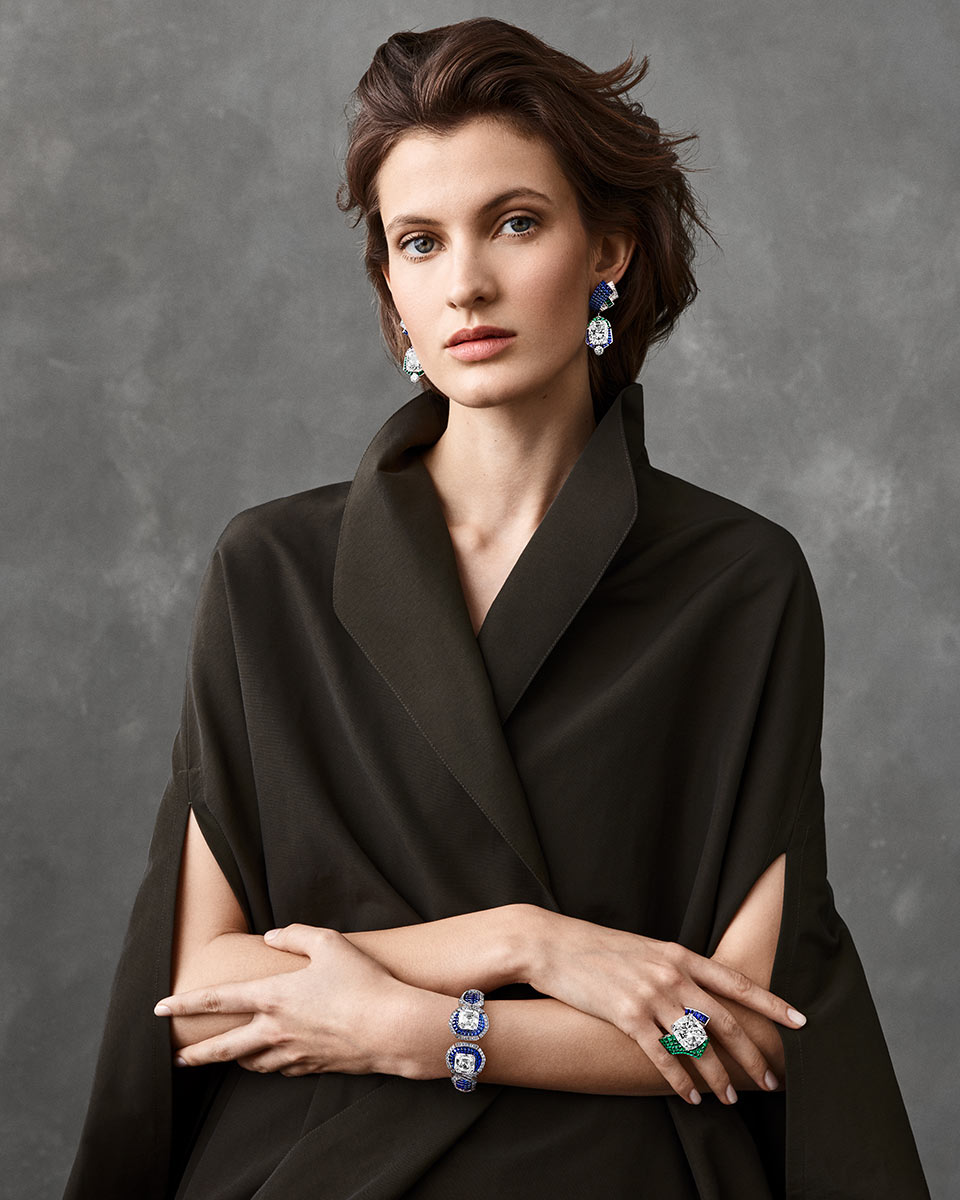
Two generous Asscher-cut diamonds face each other on the Entrelacs Mystérieux bracelet. They are perfectly paired, with their matching color, purity, and brilliance highlighted by a preciously identical weight of 10.88 carats each. The Asscher cut refers to an octagonal shape that is a variation of the emerald cut which multiplies the reflections inside the stone, revealing the intense brilliance of its fire. Contrasting with the graphic lines of the center stone, the piece’s design echoes the various torque bracelets that have marked the history of Van Cleef & Arpels’, such as the Cornucopia from1924. Traditional Mystery Set sapphires alternate between convex and concave shapes along the creation. The buff-topped sapphire surface – polished on the visible part – gives the piece a silky look that is enhanced by rows of diamonds snaking across the bracelet. They intertwine, alternating around and baguette-cut diamonds to surprise and dazzle the eye.
The Écho Mystérieux earrings and ring feature three diamonds: a pair of 12.65 and 12.61 carats and a 25.06-carat stone. The gentle silhouette of the cushion cut combines the intense brilliance of 57 facets with a surface that is large enough to reveal the limpidity of the material. The Maison particularly appreciates working with this shape, both for its charm and its ability to highlight the diamonds’ fire – t hose rainbow-colored glints. Here, the stones contrast with the deep color of the sapphires and the emeralds’ intense green. The latter are assembled using the Traditional Mystery Set technique and their surface is buff-topped, accenting the pieces’ velvety look. The earrings match without being identical, with the colors reversing from one piece to the other. They give rise to cut from the same rough stone complete the piece. The ring reveals delicate reliefs, with the central diamond set on a structure with slightly raised prongs. With an offset placement between two fingers, the stone peaks at the top of a Mystery Set ribbon whose asymmetrical movement dresses the hand with a modern touch.
